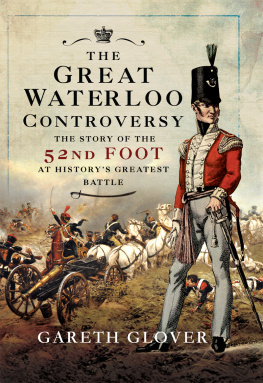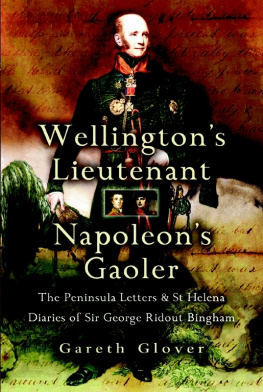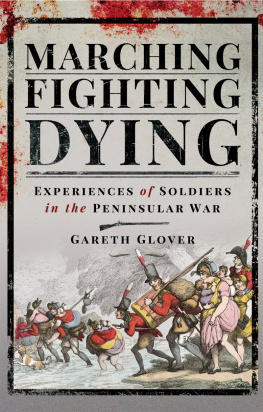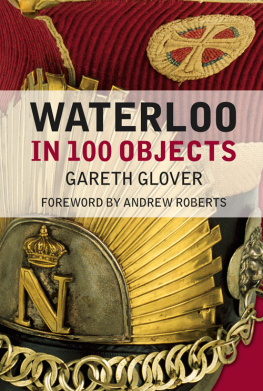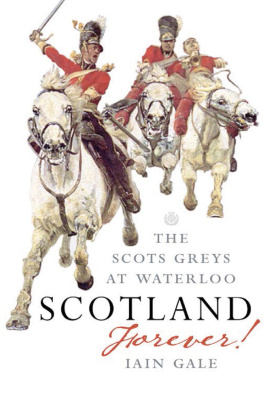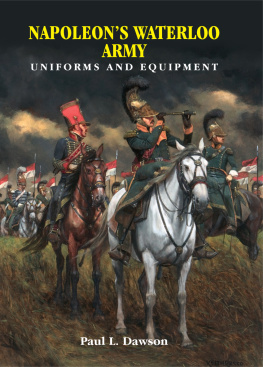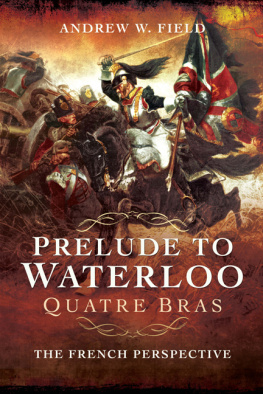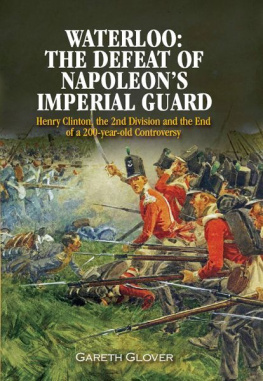A SCOTS GREY AT WATERLOO
A SCOTS GREY AT WATERLOO
THE INCREDIBLE STORY OF TROOP SERGEANT MAJOR WILLIAM CLARKE
Edited By
Gareth Glover
A SCOTS GREY AT WATERLOO
The Incredible Story of Troop Sergeant Major William Clarke
This edition published in 2017 by Frontline Books,
an imprint of Pen & Sword Books Ltd,
47 Church Street, Barnsley, S. Yorkshire, S70 2AS
Copyright Gareth Glover, 2017
The right of Gareth Glover to be identified as the author of this work has been asserted by him in accordance with the Copyright, Designs and Patents Act 1988.
ISBN: 978-1-47389-401-3
eISBN: 978-1-47389-403-7
Mobi ISBN: 978-1-47389-402-0
All rights reserved. No part of this publication may be reproduced, stored in or introduced into a retrieval system, or transmitted, in any form, or by any means (electronic, mechanical, photocopying, recording or otherwise) without the prior written permission of the publisher. Any person who does any unauthorized act in relation to this publication may be liable to criminal prosecution and civil claims for damages.
CIP data records for this title are available from the British Library
For more information on our books, please visit
www.frontline-books.com ,
email
or write to us at the above address.
List of Plates
The ruins at Dane John in Canterbury where the Scots Greys feared to patrol at night.
A typical smuggling operation which the Greys spent so much time trying to capture or disrupt.
The Scots Greys in a Bivouac, a painting by James Howe.
A typical Irish whiskey still set up in a woodland clearing to avoid detection.
The Dawn of Waterloo 18 June 1815, by Lady Elizabeth Butler.
The Scots Greys by Giuseppe Rava.
The 92nd Highlanders join the Charge, a painting by Stanley Berkeley.
Scotland Forever, by Lady Elizabeth Butler.
The Greys Charge the French Infantry by Norrie.
Sergeant Ewart captures the Eagle, by William Holmes Sullivan.
Sergeant Ewart leaves the Field with the Eagle, by Simpkin.
Eagle of the 45e Ligne Captured by Sergeant Ewart.
The Battlefield on 19 June 1815, by Matthew Dubourg.
The National Monument to the Dead of the Napoleonic Wars, Edinburgh.
George IV Entering Princes Street 1822, by William Turner.
The Procession of George IV 1822, by John Wilson Ewbank.
Foreword
O nce in a while a real gem of a personal narrative written by a soldier in the ranks who fought at the Battle of Waterloo is still discovered and this narrative by Troop Sergeant Major William Clarke of the 2nd Royal North British Dragoons (Scots Greys) is certainly one of the best I have ever read. It has to be wondered where these treasures appear from after 200 years, but in this case we do have some reasons which may explain why it has lain hidden for such a long time. This huge single volume of over 600 handwritten pages was recently purchased by the John Rylands Library in Manchester as an anonymous unpublished Victorian novel, giving the story of two soldiers discussing their lives over a few beers in a public house. It is probably because of this, that this failed novel had simply sat within the collection of a Manchester bookseller for many years, largely ignored until his widow offered it to the library a couple of years ago. Luckily John Hodgson, Joint Head of Special Collections at the John Rylands, and I have had some previous contact over the huge archive of General Henry Clintons papers also held at the library. John had rightly identified that although written as a novel, that there appeared to be the account of a genuine soldier who had fought at Waterloo in the Scots Greys running through the account, as it betrayed a very high level of knowledge of the life of a soldier. Although the book is anonymous, it at one point identifies the main character as simply as W.C., which John had surmised might well refer to Troop Sergeant Major William Clarke of the Scots Greys. At this point John kindly contacted me and I eagerly arranged to travel to the library to view and photograph every page to investigate it further and to transcribe it ready for publication.
William Clarke has left us two other short accounts of Waterloo which can definitely be attributed to him with certainty, a letter which he wrote to his parents dated from Nanterre near Paris on 8 July 1815 which is held by the National Library of Scotland. Having studied these two versions, and then comparing them carefully with the soldiers tale as depicted within the novel, it is perfectly clear that it is simply a much fuller description of his experiences at the Battle of Waterloo; indeed before his description of Waterloo begins in the novel, he has abandoned such pretentions and simply narrates his experiences. The novel in fact describes all of the military career of William Clarke from his enlistment in 1803 until he was discharged from the army in 1825, including his years on Home Service across Britain including Ireland, often carrying out operations on the Prevention Service with the local Customs Officers or policing the cities at times of unrest. He paints an intriguing and fascinating picture of military life in the army of George III, but more particularly, he describes Waterloo, particularly the day after the battle, when he was part of the Burial Party, in finer detail than anyone else I have ever read. His story culminates with an exceptionally detailed account of King George IVs state visit to Scotland in 1822, Williams last great event before he retired. Everything that is described coincides perfectly with the known service history of William Clarke, including his marriage in Ireland in 1809, this is without doubt the life of Troop Sergeant Major William Clarke.
William Clarke was born at Prestonpans, Haddington, Scotland in 1785 His length of service was officially listed as 22 years and 166 days, plus two additional years for serving at Waterloo. William retired to become a gardener, although he is recorded in his discharge papers as being worn out from length of service. As to his conduct in the army, his official record would appear to be unblemished, his promotion being steady and he never suffered demotion for any misdemeanours; but his discharge papers record intriguingly that his conduct had been good, with the exception of having involved himself in pecuniary difficulty. This may indicate that he may have got into trouble with the troop finances, but no official sanctions ensued, beyond perhaps a gentle persuasion to retire. William Clarke was, however, 40 years of age and it was normal to retire at such an age, so perhaps it was not serious enough to cause his dismissal, we will probably never know.
William does occasionally mention having a brother named Mark in the army, who also served at Waterloo, both luckily surviving without a major injury, Mark only receiving a slight wound in the right leg. The only Mark Clarke that can be discovered in the records who came from Scotland and served at Waterloo was a private in the 79th (Cameron Highlanders) Regiment of Foot. If indeed as seems likely, this is Williams brother, then their parents were John Clark and Betty (ne Bene). He was apparently two years younger than William being born on 6 November 1787 at Kilmadock near Perth, but he was also recruited when aged 18 at Glasgow for unlimited service on 28 June 1805, his previous career also listed as a gardener. On his army records, Mark is shown as having been a little shorter than William at 5ft 9in (1.75m) but with a similar colouring, having dark brown hair, grey eyes and a dark (swarthy) complexion. Mark saw a great deal of service with the Cameronians, serving at Copenhagen in 1807, Portugal and Spain in 1808, the Walcheren campaign, Portugal, Spain and Southern France from 181014 including serving at the siege of Cadiz, the battles of Bussaco, Fuentes de Ooro, Salamanca, the siege of Burgos, Nivelle, Nive, Toulouse and of course Waterloo, where he served in Captain Macleans grenadier company. The regiment also served at Corunna and Vitoria, but presumably Mark was absent sick or on detached duty on these occasions. Intriguingly, Mark was discharged from the army as unfit for service within six weeks of his brother on 6 February 1826 at the age of 38 having served 22 years and 219 days (including his two years for Waterloo). His general conduct was listed as indifferent, but now improved, perhaps hinting at why he never rose in rank.


